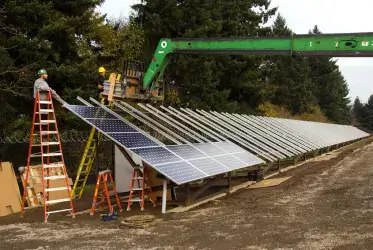
A Trillion Tons
There is a consensus among scientists that stark dangers await in a world where the global mean temperature rises by more than about 2 degrees Celsius. That threshold corresponds to a collective human carbon emissions “budget” of around a trillion tons, of which half has been spent. This paper uses a new simulation model to look at strategies to stay within that budget, specifically assessing the impact of improvements in energy efficiency, aggressive deployment of renewables, and energy technology innovation.
Does the American Public Support Legislation to Reduce Greenhouse Gas Emission?
Despite efforts by some congressional legislators to pass laws to limit greenhouse gas emissions and reduce the use of fossil fuels, no such laws have yet been adopted. Is this failure to pass new laws attributable to a lack of public desire for such legislation? Data from national surveys support two answers to this question.
The Collapse of Western Civilization: A View from the Future
Authors' note: Science fiction writers construct an imaginary future; historians attempt to reconstruct the past. Ultimately, both are seeking to understand the present. In this essay, we blend the two genres to imagine a future historian looking back on a past that is our present and (possible) future.
Why & How Governments Support Renewable Energy
Many countries have adopted comprehensive policy frameworks to support renewable energy, but the United States has not adopted any consistent and stable policies at the national level to foster the use of renewable energy. This essay explores why some nations (Germany, China, and Denmark) and certain U.S. states (Colorado, Texas, and Ohio) have developed robust policies for the deployment of renewable energy.
Reducing Carbon-Based Energy Consumption through Changes in Household Behavior
Actions by individuals and households to reduce carbon-based energy consumption have the potential to change the picture of U.S. energy consumption and carbon dioxide emissions in the near term. To tap this potential, however, energy policies and programs need to replace outmoded assumptions about what drives human behavior; they must integrate insights from the behavioral and social sciences with those from engineering and economics.
The Public Acceptance of New Energy Technologies
In the wake of ominous results about the impending path of climate change, and with gasoline prices hovering around four dollars per gallon, the 2012 presidential and congressional campaigns are full of claims and counterclaims about the transformation of the U.S. energy system. Although much discussion has centered on the need for new energy technologies, this debate as yet has been narrow and limited. Meaningful deployment of any technology will raise questions of public acceptance.
The Transnational Politics of Energy
Creating effective energy policy is hard, in part because it often requires effective international coordination. For most salient energy-related issues – such as control of the emissions that cause global climate change or the building of stockpiles to make oil supplies more secure – international coordination is inherently difficult.
The Institutional Blind Spot in Environmental Economics
Economic approaches are expected to achieve environmental goals at less cost than traditional regulations, but they have yet to find widespread application. One reason is the way these tools interact with existing institutions. The federalist nature of governmental authority assigns to subnational governments much of the implementation of environmental policy and primary authority for planning the infrastructure that affects environmental outcomes.
Designing a Durable Energy Policy
Although the U.S. energy system seems to resist the changes necessary to meet today's challenges related to energy security and climate change, the system has gone through massive change several times since 1850. A major driver in each of these earlier transitions was an economic value, such as mobility, that markets could capture.
Rethinking the Scale, Structure & Scope of U.S. Energy Institutions
This essay notes some of the key institutions created in the twentieth century for the purpose of delivering energy in North America. Those institutions are being challenged by a combination of stresses in three interconnected areas: reliability, economics, and environmental sustainability. The essay argues that these three stresses create an “energy trilemma” requiring institutional reform.
Energy in the Context of Sustainability
Today and in the coming decades, the world faces the challenge of meeting the needs of a still-growing human population, and of doing it sustainably – that is, without affecting the ability of future generations to meet their needs. Energy plays a pivotal role in this challenge, both because of its importance to economic development and because of the myriad interactions and influences it has on other critical sustainability issues.
